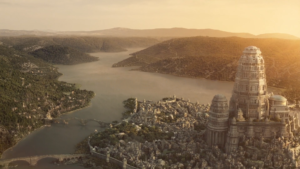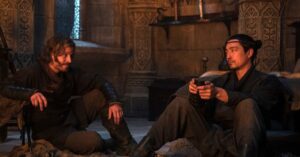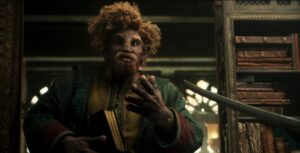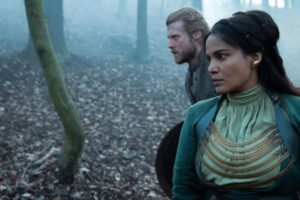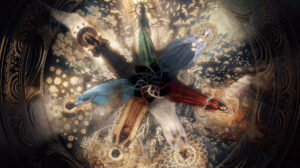SPOILERS FOR THE WHEEL OF TIME EPISODE SEVEN AND BOOKS AHEAD!
Tug a thread carelessly from any piece of fabric, and it will begin to unravel. The same is perhaps doubly true of story-threads, especially in a narrative as carefully and deliberately woven as The Wheel Of Time. Many of the major events and character moments in the fourteen-volume book series, written and published over a span of roughly twenty-nine years, were plotted out by author Robert Jordan from near the beginning of the series, allowing him to layer foreshadowing into the early books for story beats that wouldn’t transpire until after his death in 2007, when Brandon Sanderson completed The Wheel Of Time.

This hasn’t prevented Amazon Prime’s adaptation from rearranging the order of events and character introductions, excising or swapping out characters and locations, or otherwise streamlining Jordan’s sprawling series, but until episode seven these changes haven’t dramatically altered the predetermined course of the story and individual character arcs. Most of the material in the Baerlon and Caemlyn chapters of The Eye Of The World, for instance, has simply been redistributed across the width of the first season – including the character of Min Farshaw (Kae Alexander) who’s been transported halfway across the map from Baerlon to Fal Dara.
But those changes were part of showrunner Rafe Judkins’ plan for The Wheel Of Time, and he and his team of writers had already comfortably integrated them into the story by the time filming began. By contrast, it does not appear that anyone foresaw Barney Harris’ abrupt departure midway through filming, and if I had to hazard a guess based solely on the quality of the scripts for the last two episodes, I’d wager that the writers were not provided anywhere near enough time by Amazon to try and work around Harris’ absence in such a way that it felt planned.
To be fair, it’s a miracle that the loss of a series lead – coupled with COVID-19 and budget constraints – didn’t halt The Wheel Of Time dead in its tracks, and that they were able to move forward at all with revised scripts and a new direction for Harris’ character, Mat Cauthon. Judkins wisely chose to put off the recasting process until he had time to fully devote himself to finding the right actor for the role, but the consequence of that decision is that Mat doesn’t appear again between episode six and a few moments worth of presumably repurposed footage in episode eight.
Now, anyone who’s read The Wheel Of Time knows that major characters often disappear for entire books to go do their own thing, and Mat is one of those characters. But that’s roughly halfway through a fourteen-book series, after readers have gotten to know, and to care for, and to love Mat Cauthon. The effect is quite different when you’ve only got to know a character throughout six episodes of a crowded debut season, the last four of which said character spent being driven mad under the influence of a cursed dagger. If I didn’t know why I should care about Mat by virtue of having read the books, I’m not sure I would.
And all of that is exacerbated by the shoddy justification for Mat’s decision not to enter the Waygate at the end of episode six; that he has an “inherent darkness” within him that’s apparently pushing him towards the Dark One. It only further alienates the character from the audience at a point where he’s not here to defend himself, and clashes with what we thought we knew about Mat given that his only firmly-established character trait was a selfless desire to help his family that was driving him away from his destiny, but certainly not to the Dark One’s side.
It’s a flimsy excuse and a hurtful one, not only to Mat but to the characters forced to halfheartedly state it as if it’s an irrefutable fact that Mat’s already succumbed to the darkness. I could perhaps get onboard with the idea that Moiraine Damodred (Rosamund Pike), ever the wariest of the Aes Sedai, would be reluctant to bring Mat near the Dark One because of his exposure to darkness through the cursed dagger, but I can’t easily accept that she never actually intended to bring Mat to the Eye of the World, as she claims in hushed tones to Lan (Daniel Henney), until I understand why she brought Mat to the Waygate at all in that case.
If he hadn’t decided to stay put of his own accord, was she planning to kill him in the Ways or after reaching their destination? Did she have a reason for telling him where she was going if she genuinely feared that he would join the Dark One? And if she always planned to send the Red Ajah after him, why not do so back in Tar Valon, when she could have used the opportunity to appease Liandrin Guirale? If, on the other hand, she’s doing all of this for Mat’s protection, why not leave him in safe hands instead of stranding him in the middle of nowhere near a Waygate he can’t open even if he wanted to?

The one person you can usually rely on to see through Moiraine’s smokescreens is Nynaeve al’Meara (Zoë Robins) – so naturally in this situation, instead of demanding truth from the Aes Sedai or fighting to reopen the Waygate, she’s quickly convinced that that would be impossible and decides to follow Moiraine into the darkness of the Ways, remarking that they’ll find Mat once they’re out (a promise she doesn’t even attempt to keep once they reach the city of Fal Dara). Soon, the only character consistently standing up for Mat is Rand al’Thor (Josha Stradowski).
If the intent behind all of this was to endear Rand to viewers just in time for the big twist that he’s also the Dragon Reborn, it comes at the cost of exposing the lack of character development amongst all the Emond’s Field Five (well, four now), and is undermined by Rand himself. I get that Rand makes himself unlikable in the books to try and distance his friends from the fallout of his actions, but that plot-device is so poorly utilized here that it alienates us from Rand without providing any reason to keep sympathizing with him.
Gone is the quiet yet affable sheepherder whose presence we tolerated through the first six episodes; in his place is the sullen, irritable woolhead I fear we’ll be burdened with from this point hence. Not content with privately pushing his friends away one-by-one, Rand stirs up drama between them and stokes rivalries and divisions in the group under the pretense that he’s trying to unite them against Moiraine. He leaps at the opportunity to berate Egwene al’Vere (Madeleine Madden), calling her out for doubting Mat and not having his back when Rand did.
But this argument – this entire subplot – hinges on the viewer knowing these three characters more intimately than The Wheel Of Time has actually allowed us to, even seven episodes deep. Egwene and Mat only shared a handful of scenes in the first two episodes before separating at Shadar Logoth, and never had any interactions in which Rand could plausibly have interpreted some sort of animosity on Egwene’s part, so everything they’re arguing over in episode seven is largely meaningless to us, based on stuff that I guess must have happened before we entered the story.
And, well, don’t even get me started on the other big revelation that comes out of this argument. At some point while everyone is fighting, Nynaeve blurts out that Perrin Aybara (Marcus Rutherford) had an unrequited crush on Egwene while married to Laila, something that comes as a shock to Egwene, to Rand, and to us, the viewers. Technically, this is not a new development. Perrin was implied to have a slight crush on Egwene in The Eye Of The World, but Jordan never referenced it again afterwards. It was unbelievable even by his standards, and that’s saying something.
So obviously there was a great deal of shock and disappointment from fans (including myself) who felt that Perrin’s crush on Egwene maybe wasn’t the most vital part of the books to bring over into live-action. Don’t get me wrong, I like relationship drama in my fiction as much as anybody; when it’s just the right amount of juicy and spicy, that’s good stuff. But this is neither. It’s the bare bones of a love-triangle, which is already a generic trope, but on top of that Perrin never indicated any romantic interest in Egwene ever, and now I’m supposed to believe that his marriage was on the ropes because he couldn’t get over her?
Perrin’s wife, Laila, has lingered in the back of my mind as I’ve waited for The Wheel Of Time to reveal why she existed in the first place except to die horribly and motivate her grieving husband. Supposedly, part of the thought process behind her inclusion was that aging the main characters up from teenagers to twenty-something adults in the show required them to act more mature, and to come across as more comfortable in their love-lives than the helplessly awkward, angsty protagonists of Jordan’s books. A married Perrin exemplified that. The ham-fisted reveal that he was secretly crushing on his best friend…eh, not so much.
It’s obviously insulting to Laila. As if the poor woman didn’t go through enough, trapped in an apparently listless marriage and fridged by her own husband with an axe to the stomach (against Brandon Sanderson’s wishes), now the secrets she confided in Nynaeve to keep are shared with a roomful of her friends and enemies. Not to mention the fandom is still convinced she was a Darkfriend, no matter what Rafe Judkins might say. But perhaps The Wheel Of Time is even crueler to Perrin, who’s spent most of season one cycling through pointless subplots, patiently waiting for the show to remember that he’s a major character.
Hopefully he can hang in there a little while longer, because as Judkins himself revealed, Perrin was intentionally sidelined throughout this season to preserve the mystery around the identity of the Dragon Reborn, which Judkins worried non-readers might have solved on their own if The Wheel Of Time had explored how far Perrin’s connection to the wolves goes.
Personally, I feel like the guy who can literally talk to animals would have shot to the top of my list of potential Dragons if I didn’t already know it was Rand going in, but be that as it may, the mystery resolves itself at the end of episode seven and…Perrin still gets nothing to do with wolves in the finale, because he’s burdened with the role that was clearly meant to be Mat’s before these episodes were heavily rewritten.
That said, the mystery was effective in at least one regard. It got non-readers talking and speculating and having fun watching The Wheel Of Time, trying to guess the identity of the Dragon Reborn based on the limited clues that the writers were willing to spare. And at the same time, book readers got a good chuckle out of watching those reactions, or, alternatively, felt their hearts sink to their stomach when they saw how non-readers reacted with joy to the misdirect that Nynaeve was the Dragon.
I admit to being partially biased in this matter because I never liked Rand, and about five books into the series I basically had to reconcile with the fact that I was only tolerating him because the supporting cast was worth the blood, sweat, and tears required to make it through every one of his POV chapters. I proceeded to tolerate Rand for the next seven books. The experience left me tired – and in need of more likable and offbeat protagonists. Learning that some fans really adore Rand is something that invariably shakes me to my core, although I suppose after a couple rereads one grows numb to the pain.
But on a serious note, I really love hearing the various reasons why people like Rand because I can see the potential in his arc. For Rand, the responsibility of being the “chosen one” is claustrophobia-inducing, because he can never be free of it. Wherever he goes, his very existence alters the Pattern and causes irrevocable damage to the people he loves. He’s haunted day and night by the deranged musings of the last Dragon, Lews Therin Telamon. He’s hounded by the Dark One and the Aes Sedai. The corrupted male half of the One Power offers no escape, only a constant reminder of his duty to “cleanse the taint”.
Fittingly, Judkins stages the Dragon reveal in episode seven as a revelation for the audience, but not for Rand. A montage of flashbacks to recontextualized moments throughout the season tell us that Rand has actually suspected that he is the Dragon Reborn for a long time; since he channeled in the Ways to kill a Trolloc and let Egwene take the blame; since he used weaves of saidin to escape from Dana (Izuka Hoyle) in episode three; since the Battle of Bel Tine, when his delirious father Tam al’Thor (Michael McElhatton) revealed that Rand was actually born far from the Two Rivers, on the blood-soaked slopes of Dragonmount during the Aiel War.

The cold-open for episode seven takes us back twenty years to that battle on Dragonmount (known simply as the “Blood Snow”), giving non-readers an indelible mental image of the ferocity and determination they should come to expect from the Aiel – and therefore from Rand. Vikings director Ciaran Donnelly brings an expertise in shooting raw and gritty action to the table, coupled with an almost painterly understanding of how to elegantly compose and choreograph scenes of brutal violence so that they remain one step removed from the hyper-realism of Game Of Thrones‘ early seasons.
The Wheel Of Time is the kind of fantasy show where a pregnant woman in labor can climb up a mountain in the middle of winter, leap through the air with a heavily-armored man in tow before killing him and several others in intense hand-to-hand combat, sustain a stab-wound to the stomach, and only finally die after giving birth to a healthy baby. It’s fantastical, which is refreshing in this case because the fantasy genre is usually known for mercilessly slaughtering mothers and their babies in numbers that rival Disney’s kill-count. Tigraine Mantear (stuntwoman Magdalena Sittova) reclaims agency over the last moments of her life and goes out like a warrior.
A private audience with the seer Min Farshaw confirms Rand’s suspicions that he was adopted by Tam in the aftermath of the Blood Snow, while tentatively establishing the groundwork for a romantic relationship between their characters. If they’re not quite as flirty off the bat as some fans had hoped, it’s only because Rand has just been informed that there’s a strong likelihood he’ll die the very next day, and it kind of throws a damper over any flying sparks. But Amazon’s Wheel Of Time is taking a slow-burn approach to the canonical romances, so I wouldn’t have expected Rand and Min to fall in love yet anyway.
Jordan had many strengths as a writer, but romance was not one of them. His canonical couplings often play out like some of the weirdest and most random “crackships”, with characters falling in love on their first meeting, or on a whim after several books. Even Nynaeve and Lan, whom most fans (including myself) agree are perfect together, are revealed to be deeply in love with each other almost as a side-note nearly fifty chapters into The Eye Of The World. Amazon ‘s Wheel Of Time follows that relationship more closely throughout the season, cluing us in to what both characters are feeling.
The mystery regarding the Dragon Reborn adds a sense of urgency to their relationship in episode seven, as Lan and Nynaeve are both aware that if Nynaeve is the Dragon, there’s a good chance the Dark One will kill her at the Eye, and if she’s not, she’ll almost certainly be obliterated in the clash between the Dark One and the actual Dragon. Either way, the outcome doesn’t look good, and Nynaeve resolves to die having loved Lan as fully as she can. Not content with longing from afar, she joins Lan at his home in Fal Dara, where she meets his foster-family, before returning to his bedroom with him.
Or rather, Lan returns to his bedroom without even kissing Nynaeve goodnight, and Nynaeve enters a minute or two later as he’s getting undressed for bed. Lan can’t bring himself to tantalize her with what they both know is beyond their reach, but Nynaeve is living in the moment, accepting that she’ll probably never have the chance to settle down with Lan or start a family – hell, she’ll be lucky if she survives one more day, but at least right now they can have this together. Before we cut away and leave them to their lovemaking, the unshakable, headstrong Nynaeve we adored is back.
Even in Jordan’s world, the Pattern comes undone sometimes, but it always finds a way to correct itself. That process usually involves ta’veren in the books, but seeing as Amazon Prime Studios doesn’t just have one of those hanging about the place to help out (that we know of, at least), the combined talents of Rafe Judkins and his creative team will make up for the lack of cosmic intervention.

And of course they’ll make mistakes sometimes, but keep in mind that this and the next episode had to be rewritten in the middle of a pandemic to accommodate the absence of a lead actor, so the ending we got is not the ending that Judkins wanted to give us, and the slightly lower quality of these last two episodes is not indicative of where The Wheel Of Time is headed, only of how many obstacles had to be surmounted in order for this first season to see the light of day.
Episode Rating: 6.9/10



